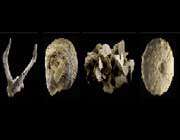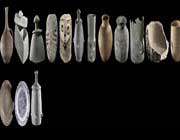Virtual Museum
UAE History - Ancient artifacts
Coins
Coinage has been used in the U.A.E. since the 4th century B.C. when the first coins in the area - imitations of Athenian types from ancient Greece - were struck. Early coins are particularly well-represented at the sites of Mleiha, in Sharjah, and ed-Dur, in Umm al-Qaiwain, and examples can be seen in the museums of both emirates. At Mleiha a local king named Abi’el used some of the very few mould-made coins in the ancient Near East. Hundreds of his original coins, as well as later copies which kept on being made into the first centuries A.D., have been found on the surface of these sites and smaller numbers have been recovered in excavations. Ed-Dur, which had extensive trading contacts with India, Iran and Mesopotamia, has also yielded examples of foreign coinage originating in all three areas. During the late pre-Islamic era, when the region of Oman and the U.A.E. came under the control of the Sasanians in Iran, Sasanian coinage began to circulate in the region. Sasanian coins are known from ed-Dur and Fujairah, where early Islamic coins have also been found. Several Islamic coin hoards have been discovered over the years in Ras al-Khaimah as well. The coins from Fujairah and Ras al-Khaimah can be seen in the archaeological museums of these emirates. In the later Islamic era coins from Iran, Iraq and India were recognized as legal tender throughout the region.
Fossils

In spite of the fact that the U.A.E. has been in existence for just under 30 years, the country has a fossil record stretching back hundreds of millions of years. The emirate of Abu Dhabi is particularly rich in fossils, although isolated geological formations in Sharjah and Dubai have also yielded important fossil remains as well, particularly of a marine nature. For many years scholars from the British Museum of Natural History in London have worked in the western desert area of Abu Dhabi where a large number of fossils have been uncovered. The types of fossil equids, elephants, hippopotami, crocodiles and other species recovered near Jabal Baynunah bear witness to a climate and environment very different from that of the present day. Watering holes, surrounded by savannah-like grassland, existed here which probably looked more like East Africa than eastern Arabia. Abu Dhabi is a palaeontologist’s dream, for not only have large numbers of fossils been discovered in the so-called Baynunah Formation, but entirely new species and animals previously unattested in the Arabian peninsula have been found there. The study of this important fossil record is providing important clues about the climate and environment of the Arabian shelf (broadly the eastern half of the peninsula) which are changing the way scientists look at the earliest phases in the history of the earth and its inhabitants.
Ceramics & stoneware

In Syria and Iran, pottery production dates back to at least 7000 B.C. In the U.A.E. pottery occurs on some of the earliest sites in the area, dating to c. 5000 B.C. The first pottery found in the Emirates was imported. It came from southern Iraq and belongs to a style known as ‘Ubaid. ‘Ubaid pottery was made of a greenish-buff fabric (the native alluvial clay of southern Iraq) painted with a thick black pigment. Yet exposure to ‘Ubaid pottery, or to another imported type from Iraq comparable to that known at Jamdat Nasr around 3000 B.C., seems not to have kicked off local production of ceramics in the region. That didn’t happen until several centuries later when an orange pottery, decorated in black, began to be manufactured which remained in use for some 700 years. Throughout all subsequent periods in the history of the U.A.E. pottery was made locally, the shapes, wares and decoration of which varied through time. At the same time, ceramics were imported from a variety of places, including Mesopotamia, Iran, Central Asia, Baluchistan and the Indus Valley. During the Islamic era locally-produced pottery was used alongside imports from China, Southeast Asia, Iraq and Iran.
Stone vessels, as well, particularly good for holding fatty or oily substances, began to be made in the area by about 2500 B.C. Most of these were manufactured from steatite or chlorite, a soft mineral found in certain parts of the Hajar mountain. During the late 3rd, 2nd and 1st millennium B.C. the U.A.E. had an extensive stone bowl-manufacturing industry which produced vessels in immediately recognizable shapes with very particular decorative patterns. Examples of such locally-made stone vessels have been found at sites in Iraq, Iran, Bahrain, Saudi Arabia, Baluchistan and the Indus Valley.
Jewellery
There are practically no archaeological sites in the U.A.E. which have not yielded some remains, however meager, of human adornment. Sites from the late Stone Age (6th-4th millennium B.C.) are often replete with beads of shell, bone and stone which would have once been strung in necklaces and bracelets. Marine shells and mother-of-pearl were sometimes artfully carved; imported stones like agate and carnelian from the Indus Valley (particularly from Gujarat) were highly sought after. Precious metals, including gold and silver, are present in small quantities and can be seen in the museums of Fujairah and Ras al-Khaimah. The recovery of nearly 13,000 beads in the late 3rd millennium tomb at Al-Sufouh in Dubai (the finds from which can be seen in the Dubai Museum) gives us an indication of just how much jewellery was used to adorn the dead of the region during the Bronze Age.
There is some suggestion that magical amulets may have played a part in jewellery as well. Early Islamic writers provide a considerable amount of information on the magical properties of amulets worn by men, women and children - amulets used as charms against disease, the evil-eye, to bring good luck, etc. Steatite pendants, probably worn around the neck as centerpieces in necklaces, have been found at a number of Iron Age sites in the U.A.E. and may have served a similar function. The Indus Valley which had a prodigious industry in the manufacture of steatite and faience micro-beads (so-called because of their minute size) exported thousands of such beads to other parts of the Near East, including southeastern Arabia.
For the complete virtual journey you can check out the following Address:
http://uaeinteract.com/history/e_muse/em_strt.asp